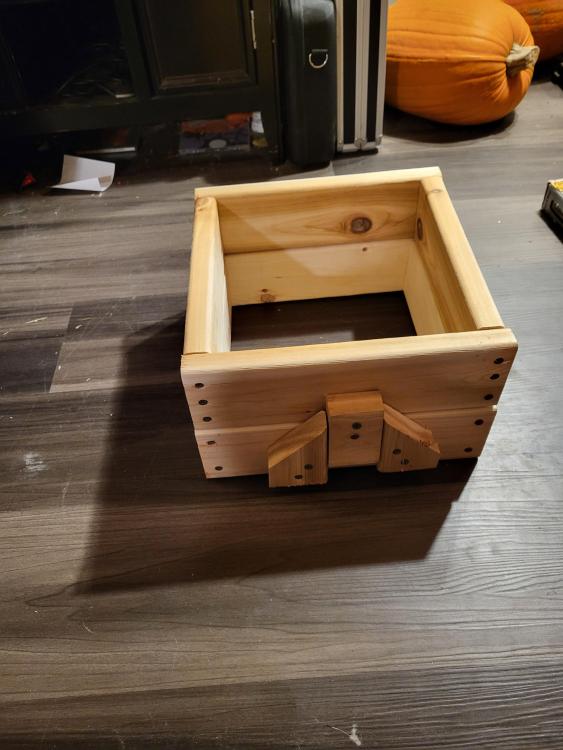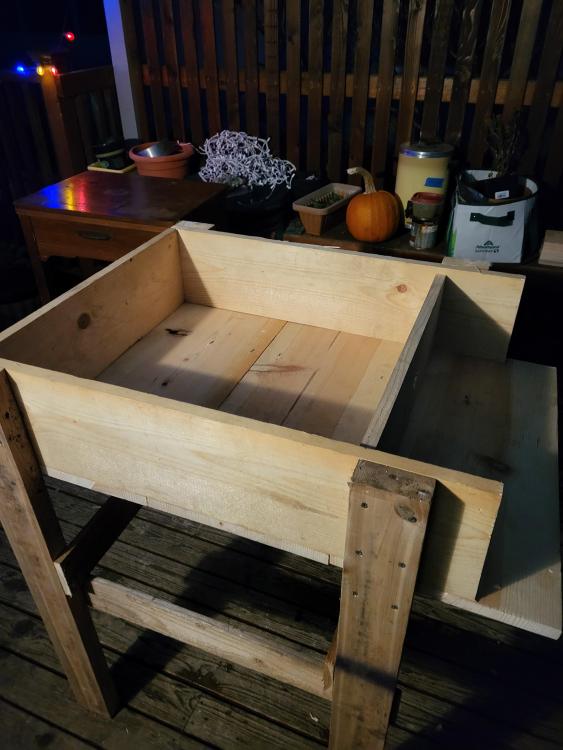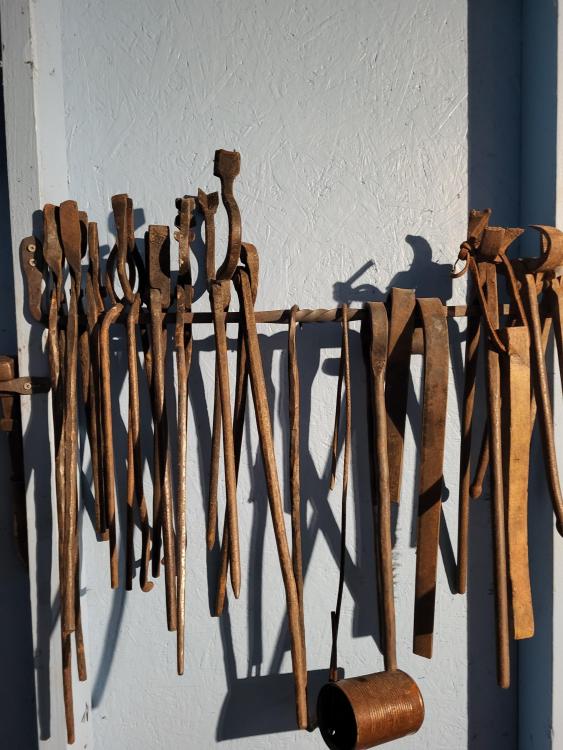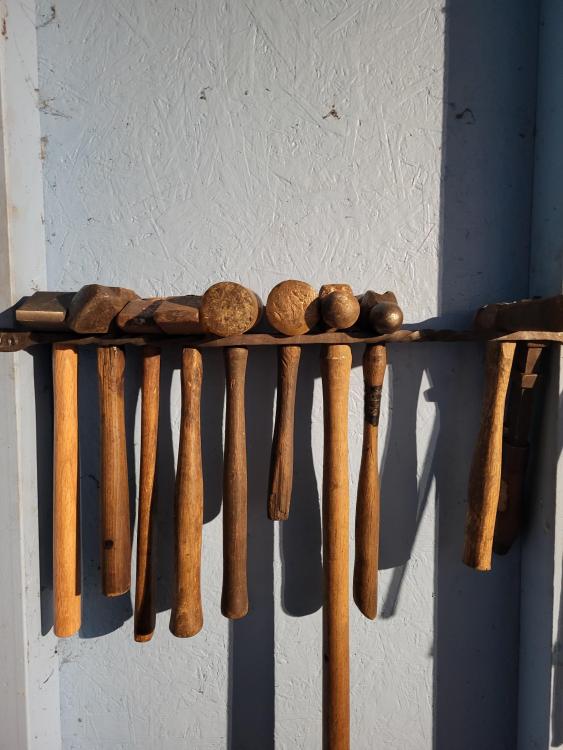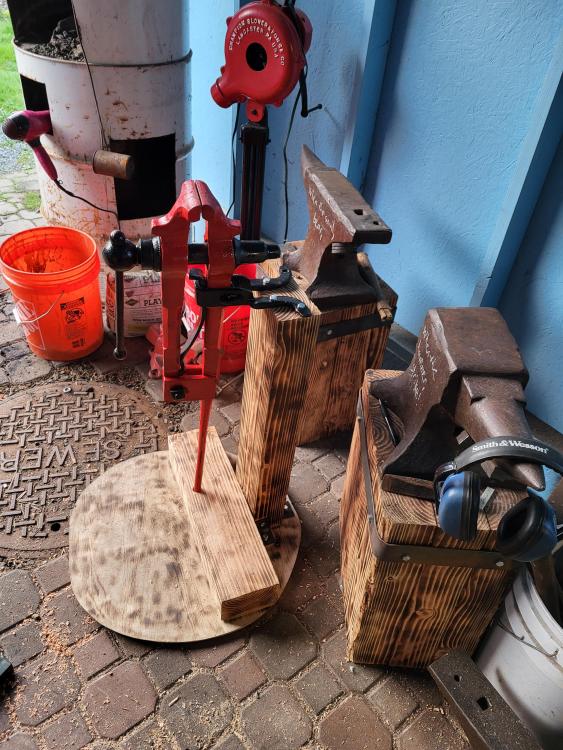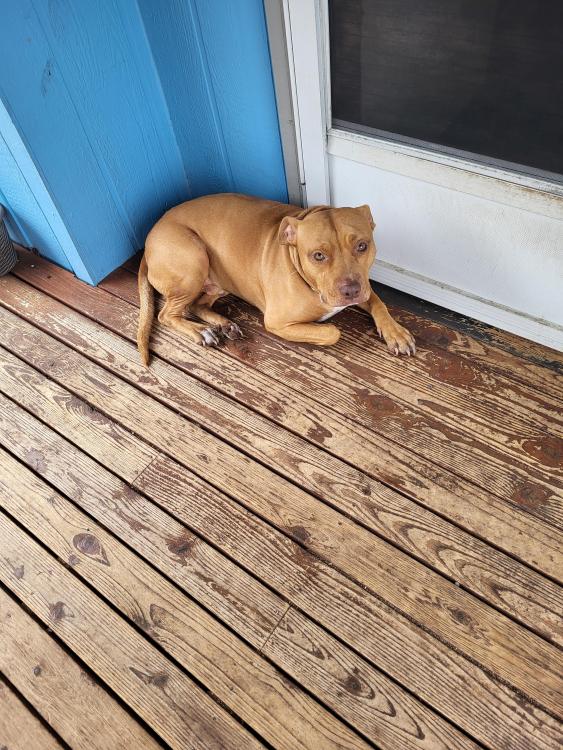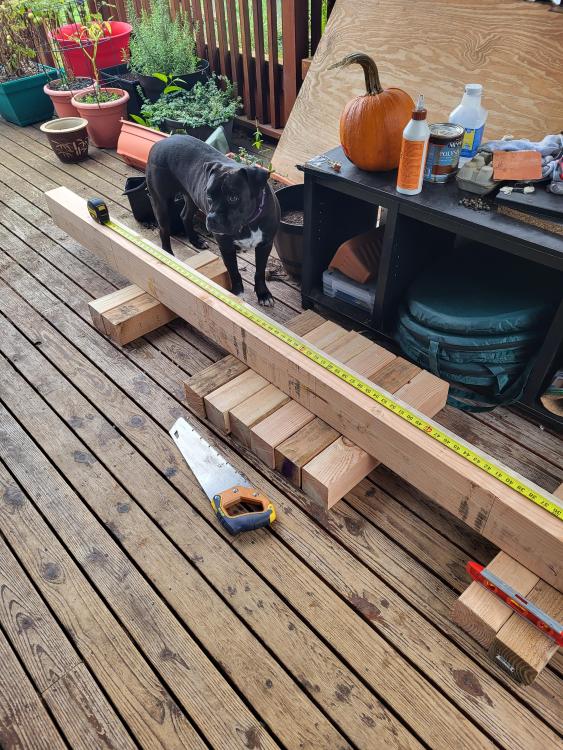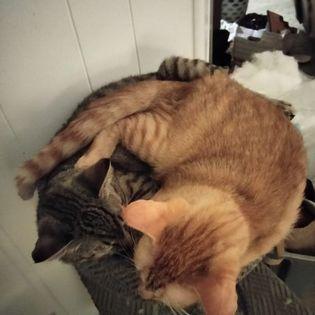-
Posts
1,583 -
Joined
-
Last visited
Content Type
Profiles
Forums
Articles
Gallery
Downloads
Events
Everything posted by Nobody Special
-
Good afternoon, I didn't make the dies. I would think that might be thick enough to warrant it, but I would tend to err on the side of too soft rather than too hard and see how that goes. Many people on here have far more experience than I do using power hammers and can probably give better advice. The area where I experienced something similar was making hand-held hammer heads; on a couple of hammers, steels that were oil quench when making blades didn't harden fully when doing an oil quench for hammer heads. Of course, it can be counterproductive to have hammer heads too hard. Also, in one case when I water hardened, I had the hammer crack at the eye after a couple of days of use, even though it was tempered softer at the eye.
-
So, looking at flame hardening, it looks like it's a form of case hardening for mid-carbon steels by means of using an oxy-fuel mix to apply flame directly to the areas to be hardened followed by a water quench, either by submersion or by spraying it with water, creating a shallow layer of martensite. The idea is to leave the surface hard, but the core softer and more ductile especially on machine parts like rail surfaces or gears that benefit from wear resistance on the surface and softness underneath. It's also supposed to be a lot cheaper than heat treating the entire part. Either that or nitriding would be something I wouldn't care to try without experience at home, especially nitriding since ammonia gas is corrosive, toxic, and displaces oxygen. I second either farming it out or getting help if you can find someone with more experience in heat treatment. You're considerably closer to the PNW Blacksmith Association meets than I am. Maybe one of them could point you in the right direction. Also, I've seen dies made from 4340; they were mostly done by heating the entire part and using an oil quench, or sometimes water for particularly thick dies. Seemed to hold up fine.
-
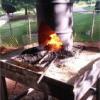
Origin backstories
Nobody Special replied to George N. M.'s topic in Blacksmithing, General Discussion
I started reading everything I could get at about age 3, which eventually led to a bunch of eclectic hobbies like knitting, beekeeping, paper cutting and all sorts of weirdness and being broke a lot helped me learn to be handy. I don't remember what drew me in to smithing; I picked up Weyger's book and a Chinese ductile iron ASO around 2004 or so at Ft. Hood, but I started with metal casting first because I thought it would be safer and easier. Feel free to snicker, it's funny now. When I came back from Iraq in 08 I started playing around with forging bits of grounding rod I heated in my casting furnace, which went about like you'd expect. When I got to Georgia a couple of years later, I read a couple of books and watched some youtube and made something like a jabod with a rotor for a firepot in an upside-down lawnmower, filled in with the same homemade refractory I had been using in casting and forging on the ASO. Eventually, I found better books and youtube blacksmiths, started hanging out on here in chat and for the lessons, and improved my equipment. Stan Schwartz, aka trying-it was a big help, but got banned after butting heads with the administrators (he was often generous and helpful but could be stubborn). Life changes stopped me from forging for the last few years (my last wife moved in with an 83-year old horse farmer, then I moved up here and married my old high school sweetheart, but limited living space and left my equipment in GA). I started up again two or three months ago, albeit a lot has been setting back up and metalwork has been only once or twice a week. -
Well, I picked up a copy of The New American Machinist's Handbook today, new to me (copyright 1955) that looks like 4340 (H?) maxes out at about 60, but in the brief bit I've had to look through it, it seemed to indicate that it wasn't the normal heat treat, and that to get that hard you would probably nitride the steel, which if I recall, involves exposing the hot metal to ammonia gas to case harden it (Theophilus much?) . That seems worth a buck from the library's book sale.
-

What did you do in the shop today?
Nobody Special replied to Mark Ling's topic in Blacksmithing, General Discussion
Don't look at me, thank the box store. Couldn't find the 1x4s I wanted to save my life, but they had pretty 5/4" x 4 cedar board at low enough prices to make me blink. The rest is just the magic of drywall screws. Like the hawk, WFF. Any pics of how the cable came out so far? -

What did you do in the shop today?
Nobody Special replied to Mark Ling's topic in Blacksmithing, General Discussion
Wife's been after me about how we still haven't been casting yet, so I made a couple of small flasks today in preparation. After I finish a few flasks, gonna make a molding table and a riddle. Then I've got to make a run to the junkyard and pick up a busted transmission case or something to break down for the aluminum. I was thinking of going through the Dave Gingery book series with her. -

Blacksmiths hammer signals
Nobody Special replied to Shabumi's topic in Blacksmithing, General Discussion
The old, "When I nod my head..."? -

What did you do in the shop today?
Nobody Special replied to Mark Ling's topic in Blacksmithing, General Discussion
Fired up the new JABOD forge and taught the youngling for awhile. He's about as enthusiastic as I've seen him regarding anything that didn't come with an on button. The forge worked sorta kinda well. Fuel consumption was down, but the fire was a little more localized than I would like; it felt like the air kept getting blocked on the sideblast. May have been that the boy went a little hardcore on busting up charcoal and there were a lot more fines than normal. We made a few squuare points, did a little square to round and back, followed by...a hook! -
The few times I've done it, I used a mid-carbon steel and they held up well. Say 40 to 60 points of carbon. Most of the ones you suggest would work fine for that, except maybe the one with 30 points of carbon which might be a bit soft. I did have one crack at the eye, made from a very old piece of axle found on the backside of an old farm. That's how I found out that heat treatment for thin pieces of mystery steel (a small test coupon made for that purpose) don't always work the same as heat treatment for thick pieces of mystery steel. But a pretty good lesson learned for only a few hours of work lost. And the rest of the axle was fantastic for busting up rocks at the bottom of post-holes.
-
I think you're right about the "pliers". Wrong shape for the bits. The medieval ones I've seen looked more like the Alexander Weygers illustrations of forged pliers with sort of triangular bits.
-

What did you do Outside the shop today?
Nobody Special replied to TWISTEDWILLOW's topic in Everything Else
I'd take maple over alder any day of the week. Alder is scary to be up in. The big thing is don't fell the whole stick unless you have to and have plenty of room. Just go up it, take the limbs off and then the trunk 18 inches at a time. More time consuming, but you never get that nasty feeling of watching the trunk come down on architecture. I was on a tree crew working ground crew when I first came up here and one of the regular cutters dropped a whole stick that went over onto a house. Learned about splitting frozen wood to bust up pecan; that wood is stubborn until it's sat for two years. Yesterday was wheel bearings in 20-degree weather and today was hauling hay after work in 25 degrees. But hey, with the inner and outer races that's material for eight new blades! -
I used to green sand cast some; that's how I got into forging sideways. Up in Washington though. I would advise that you check the Dave Gingery books for a start. There are a lot of good books out there, but he's not bad for a simple, easy to understand book on beginning green sand casting. Other advice is seek out other casters - if you can't find them in the forging community, try college art programs. Casting has a steep learning curve and many chances to obtain interesting new scars and respiratory ailments. Good equipment and ventilation is a must - especially crucibles and PPE. Stay away from zinc until you're more experienced. Fume fever sucks. I'm gradually setting up my forging area now and have been procrastinating on setting up a casting table while waiting for nicer weather. My wife wants me to teach her.
-
Jeez, next you'll be telling him about the flames freezing and putting them in the deep freeze for later. Beats heck out of matches but gets a bit messy when the power goes out...
-
Y'all got me excited for a minute, then I started looking at the NWBA meetings; they all look to be about four hours or more south of me. I wouldn't mind getting a group going up here on the north end of Washington, but I'm not set up well to host. I haven't welded on wood, but it's lovely for use with a wood mallet or rawhide mallet to straighten twisted pieces that you don't want to mar. I used to keep a sawhorse made with a chunk of railroad tie handy as an impromptu anvil for just such a purpose. Smokes a bunch but works great. As to quenching in water - I'd borrow from Thomas Powers and make a test coupon, then use whatever it quenches best in. Some do well in water, some oil, some brine, and some steels don't even get hardened from bad language and mean looks.
-

Colonial Anvil and Stump, info
Nobody Special replied to ZzzDerekzzZ's topic in Anvil Reviews by brand
Good evening, From what I recall, the step on the horn was one of the big things differentiating the London pattern anvil from the English pattern or colonial anvils (colonials tended to have smaller horns and for awhile often had the fifth step or leg on one side in the middle. Ones with stepped horns go back to between 1780 and 1800, I think...it's been a minute. Pritchel holes really started being a thing 1820-ish, and more prevalent from 1830 or so on. This puts yours at a fairly narrow probable time range, probably between say 1780 and 1820. Later anvils not only had the pritchel but also got longer and thinner. I have a William Foster Anvil that looks almost identical from 1816, except in mine the heel is broken at an old forge weld, which is common for the brand, especially due to its age. Wiliam Fosters were at that point the third most common import, and yours has the look, but many brands existed at the time that looked similar, especially the wide sweet spot (the spot over the main body). I'm not sure why they got away from the wider faces; it makes mine my favorite anvil, to work on broke heel and all. You may be able to find faint markings by tilting it slightly sideways and rubbing the side with flour, corn starch, powdered chalk, or my favorite, baby powder. It really, really brings them into relief and even partial words, numbers, and markings can help identify a maker. As a tool, with the face damage I wouldn't go very high in Massachussetts, maybe three bucks a lb unless you find someone that is sentimental over the age. As an antique? Depends on what you can get some poor fool to part with. The sky is the limit if you have the gift. -

ID for Blacksmith Vise marked MANN & CAMPBEL SHEFFIELD WARRANTED
Nobody Special replied to EdwardC's topic in Vises
I don't know the brand, but my Google-fu is strong. There was a forge in the Sheffield area called Moss & Gamble Bros Limited, Special Steels and Tools, Franklin Works, Wadsley Bridge, Sheffield, which had the distinction of having the largest steam hammer in the area at one point, in Wadsley Bridge, a suburb of Sheffield. Here's a link to their industrial works, which has since been converted to apartments. [10479] Wadsley Bridge : Moss & Gamble's | Fox Hill Road, Wa… | Flickr Not sure the exact period, but I found other blacksmith tools with their stamp. There's also a post about one of their anvils here, -
Got tired of my modified bottom blast 55-gallon drum forge with charcoal...it works, but it could do better. Started, and mostly finished a JABOD in about an hour and a half. Didn't have any 3/4" pipe laying around, so I'll clay it when I get back from drill next week. Similar to the original JABOD, two-foot box out of 1x8", side-blast with the tuyere about half-way up. Planning to make a tapered trench about four inches wide and seven to eight inches long, with the bottom at the deepest maybe five inches to start (with only 7.5" to the bottom, I don't want to overheat it and catch it on fire!). I had a similar forge in Georgia, but a bottom blast, sort of a duck's nest over a brake rotor, and hood from a small cut down oil drum. Worked well with coal.
-

What did you do in the shop today?
Nobody Special replied to Mark Ling's topic in Blacksmithing, General Discussion
Ain't much, but made a few bars to serve as tong and hammer racks. Tabs on the end, punch and simple twists for aesthetic pleasure...and also because that square stock got a good brine soak when the ocean came to see us last January. -
-

Show me your blacksmith pets
Nobody Special replied to Glenn's topic in Blacksmithing, General Discussion
To be fair, I don't mummify any part of my cats with sulfuric acid and display the corpses after they're dead, so it was already kind of a low-risk situation. -

Show me your blacksmith pets
Nobody Special replied to Glenn's topic in Blacksmithing, General Discussion
Whiskey (red nose), Moonshine (black and white), John Stuart Mill (grey tabby), and Aristotle (orange tabby). I wanted to name Aristotle Jeremy Bentham, but my wife said I couldn't have two utilitarians in the house at the same time. Joke's on her, JSM is a perfectly catty cat, and mostly only maximizes his own personal happiness. -
Welcome! We've already been talking a bit in the section on scrolling wrenches, but I've been gone a long while until recently, so I don't always know who's new. Love the look of your dog. Yours too, Frosty. I've got two pits, Moonshine (black and white) and Whiskey (red nose) In our house, dogs are alcoholic beverages, cats are philosophers (Aristotle (orange tabby) and John Stuart Mill (grey tabby)). We don't name the bees.

